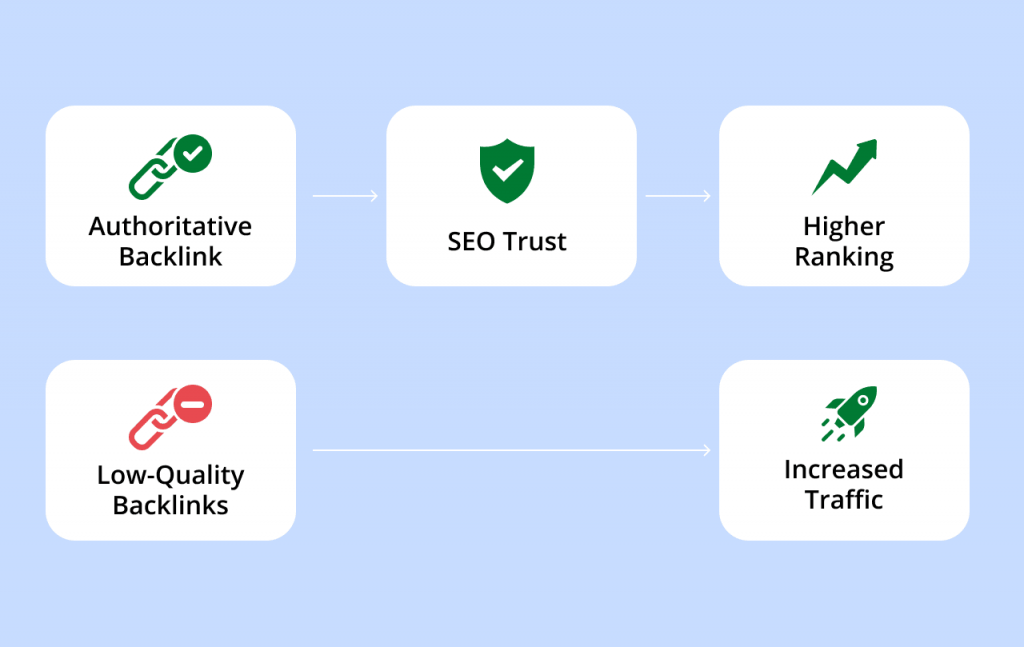Key takeaways:
- Backlinks are links from other sites that point to yours. They act like signals telling search engines your page is worth noticing.
- With more quality backlinks, it becomes easier to rank higher, pull in traffic, and build credibility.
- Every backlink has a different impact. One dofollow link from a high-authority site can outperform a large number of low-quality links.
Backlinks, sometimes called incoming links, help search engines understand your site’s relevance. One quality backlink from a trusted site can beat dozens of low-value ones. This guide shows what backlinks are, why they matter, and how to build the kind that improves your search results.
Why are backlinks important?
Search engines treat backlinks as proof that your site deserves attention. But not all links are equal. A single backlink from a a reliable, well-known site hold greater value than dozens of weak ones.
The visual below makes this concept clear.

That’s the power of quality backlinks. Here’s how they help:
- Backlinks boost search rankings
- Backlinks build domain authority
- Backlinks drive referral traffic
- Backlinks improve AI and Google visibility
Backlinks boost search rankings
Search engines reward pages that have strong backlink profiles. More high-quality links often mean better positions on search engine results pages (SERPs).
- Dofollow links from authority sites signal real value, while low-quality links do little for SEO.
- Ranking higher increases visibility, traffic, and long-term brand growth.
Backlinks build domain authority
A solid backlink profile strengthens your site’s domain authority. This metric reflects how well your pages can compete in search results.
- Links from other websites with established authority pass value to your site.
- With higher authority, your site stands a stronger chance against competitive keywords.
Backlinks drive referral traffic
Backlinks work two ways: they lift rankings and bring in direct traffic. When users click a link from a relevant page, they’re already interested in your topic.
- This referral traffic is often higher quality and more likely to convert.
- It creates a steady stream of new leads or customers for your business.
Backlinks improve AI and Google visibility
Today’s search engines like Google and AI models also use backlinks to gauge credibility. Strong backlinks can expand your reach beyond traditional search.
- Content with high-quality backlinks is more likely to be cited in AI-driven answers.
- This reinforces brand authority in both search results and AI-powered platforms.
Your backlink profile gains strength from quality, not quantity. Where a link comes from and how it’s structured determines its real value. That’s why it’s worth knowing the different types of backlinks to help focus on the ones that drive lasting SEO results.
Types of backlinks
Backlinks come in different forms, and each plays a unique role in SEO. Here are the types you need to know.
- Internal backlinks
- External backlinks
- Editorial backlinks
- Guest post backlinks
- Resource page backlinks
Internal backlinks
These are links that connect one page of your site to another. They don’t act as endorsements like external links, but they play a big role in keeping your site organized and easy to navigate. For example, linking from your homepage to a new blog post helps both users and search engines discover it faster.
How they impact SEO:
- Guide search engines through your site so more pages get crawled and indexed.
- Improve navigation for visitors, encouraging them to explore and stay longer.
External backlinks
Also called inbound links, these come from other websites. They’re among the most powerful for SEO because they show that outside sources trust your content. For example, if an industry blog links to your guide, it positions your site as an authority on the topic.
How they impact SEO:
- Act as third-party trust signals.
- Strong external links often drive rankings faster than internal ones.
Editorial backlinks
Editorial backlinks are naturally earned when another site references your content as they find it useful and trustworthy. Unlike links you ask for or create yourself, editorial backlinks come from genuine recognition of your work. They’re often seen as the most valuable type since they signal that your content stands out enough to be cited without incentives.
How they impact SEO:
- Often considered the gold standard of backlinks. For example, a journalist linking to your research or a blogger citing your guide.
Guest post backlinks
These come from writing articles on other websites and linking back to yours. When placed on trusted platforms, they build authority, expand your reach, and send qualified traffic your way.
How they impact SEO:
- Helpful for visibility and SEO if placed on relevant, trusted sites.
- Risky if done excessively on low quality sites.
Resource page backlinks
These come from curated directories or pages that collect and share useful tools, guides, or services. They work as trusted recommendations that put your brand in front of the right audience.
How they impact SEO:
- Build visibility and brand authority through credible mentions.
- Send steady, qualified referral traffic even if ranking power is limited.
Different backlinks play different roles. They also carry attributes that affect how search engines handle them. The main ones are:
- Dofollow backlinks. These are the standard website links that pass authority to your page and tell search engines that your content is valuable. For SEO, they help improve your domain authority and improve your rankings. Most editorial and organic links are dofollow by default, so they carry real weight for your online visibility.
- Nofollow backlinks. These are website links that use a special tag (rel=”nofollow”) to stop authority from passing through. They may not boost SEO directly, but they still help diversify your backlink profile and can drive referral traffic from relevant pages.

What makes a backlink valuable
The value of a backlink comes down to quality. Domain authority, relevance, and diversity of sources decide whether a link helps your SEO or makes little difference. These are the factors that define backlink value:
- Domain authority of the linking site
- Relevance of the linking page
- Placement and context of the backlink
- Diversity of backlinks
Domain authority of the linking site
Backlinks from reputable sites carry a stronger influence on rankings. Links from trusted external websites also add credibility and strengthen your overall backlink profile. For example, a link from a news outlet or industry leader is stronger than one from an unknown site. That means, a backlink from a well-established site gives your page a bigger push in search results.
Relevance of the linking page
Backlinks work best when they come from pages related to your content. If the topics line up, the link feels useful to readers and signals relevance to search engines too. For example, a fitness blog linking to your running shoe review is far more helpful than a link from an unrelated site. Links that fit the topic help show your site as a reliable resource in its niche and make your content more credible overall.
Placement and context of the backlink
Search engines pay close attention to link placement. A link in the middle of an article counts more than one at the bottom of the page. When it’s part of strong content, the link adds more credibility.
Diversity of backlinks
A healthy backlink profile comes from variety. Links from different domains show that your site is recognized widely. That’s why getting ten links from ten different sites is more valuable than ten links from the same site. The real takeaway is that more variety means more value.
Curious how to apply this to your site? Our guide to eCommerce link building has the answers.
High-quality vs spammy backlinks
Some links are helpful, others are harmful. Good backlinks come from trusted, relevant sites and give your pages more weight in search. Bad ones, often from shady or unrelated sites, can pull your rankings down. Telling the two apart helps Google decide which pages to show more often.
Here’s a quick comparison of high-quality vs spammy backlinks:
| High-quality backlinks | Spammy backlinks |
| Come from reputable, relevant sources, not spammy sites. | Often come from link farms, paid schemes, or irrelevant directories. |
| Use natural anchor text that fits the content. | Use keyword-stuffed or misleading anchor text. |
| Placed in context, often inside a blog post or valuable resource. | Found on spammy sites with thin or duplicate content. |
| Represent links pointing from diverse domains. | Large numbers of these links pointing from the same or low-quality sites can trigger penalties. |
How to get backlinks
It’s not enough to know the importance of backlinks. You need to build them in ways that bring value. Here are practical ways to make it happen:
- Create content people want to share
- Use guest posts on external sites
- Try broken link building
- Leverage resource pages and directories
- Build relationships for long-term links
Create content people want to share
High-quality guides, tutorials, and original research are the most reliable way to earn natural website backlinks. When other web pages find your content useful, they link to it as a resource.
Tips for success:
- Long-form articles and case studies attract citations.
- Visual assets like infographics are easy to reference.
- Publishing consistent SEO backlinks content signals authority to both readers and search engine bots.
Use guest posts on external sites
Contributing to relevant blogs and industry publications introduces your brand to new audiences. A well-placed link from external links builds credibility while driving referral traffic to your target page.
Tips for success:
- Focus on quality over quantity.
- Make sure your anchor text feels natural and relevant.
- Avoid over-relying on nofollow links from low-authority sites.
Try broken link building
This tactic helps you replace outdated or dead links with your own content. By suggesting your page as a replacement, you provide value to site owners while gaining backlinks in return.
Tips for success:
- Search for broken link building opportunities with SEO tools.
- Offer a replacement page that closely matches the original content.
- Works best when the linking site already has strong page and domain authority.
Leverage resource pages and directories
Niche directories and curated resource lists are often overlooked. Getting listed on these web pages may not be as powerful as editorial links, but they can still bring steady traffic and visibility.
Tips for success:
- Submit your site to respected directories in your industry.
- Focus on relevance to avoid being grouped with spammy sites.
Build relationships for long-term links
Networking with bloggers, journalists, and industry leaders can open the door to mentions, interviews, and natural backlinks. Building genuine relationships also increases the chances of your content being cited and shared over time.
Tips for success:
- Strong relationships lead to internal links within partnerships and collaborations.
- Media features often deliver backlinks from authoritative domains.
- Over time, this boosts your presence in search engine rankings.
Getting backlinks requires both strategy and persistence. From broken link building to creating content that earns natural mentions, the goal is to build links that support your authority in search engine rankings. For a complete roadmap, check out our SEO Strategy Guide to learn how backlinks help push your site higher and power up long-term SEO success.
Tools and metrics to check backlinks
After you start building links, it’s important to track your progress. These tools and metrics show how your incoming links are helping your site move up in Google rankings.
Google Search Console
A free way to monitor your linked pages and see how many backlinks point to your site. Here’s how what it does:
- It shows incoming links from external websites.
- It helps you understand which web pages earn the most attention.
- It’s useful for spotting new opportunities to earn backlinks.
Other SEO tools
There are also third-party SEO platforms that offer deeper backlink analysis, including:
- Domain authority scoring
- Anchor text insights
- Referring domain tracking
These tools can complement your SEO strategy by offering more detailed link data and competitive insights.
Key metrics to focus on
Backlinks matter for SEO success, but value depends on quality, not just numbers. Look at:
- How many backlinks are pointing to your site (overall volume).
- Page and domain authority of the sites linking to you.
- Relevance of each linked page and diversity of sources.
So, keep an eye on your backlinks. Not just the numbers, but the quality behind them. When you track authority, relevance, and diversity, you’ll know which links truly push your SEO forward.
And for broader site health and keyword insights, our Simple SEO Tool helps you stay on top of technical fixes and optimization tasks, so your link-building efforts lead to real, measurable results.
Strengthen your link building
Backlinks are still a top driver of SEO growth. They help search engines recognize your site as trustworthy, boost your authority, and bring steady referral traffic. The key isn’t collecting as many as possible but building the right ones.
If you’re ready to grow your rankings with smarter SEO strategies, our SEO services give you expert guidance and hands-on support to strengthen your backlink profile, improve visibility, and build long-term authority online.
Talk to one of our SEO experts today!
Frequently asked questions
An example is when a food blogger writes a blog post reviewing kitchen tool and includes a link to a small business website that sells cookware. This kind of backlink directs readers to the target page while showing search engines that the content is trustworthy. Real-life scenarios like these show how businesses earn backlinks through relevant, organic mentions, which is why link building remains a core part of SEO.
Yes, backlinks are a normal and legal part of how the web works. They’re just links from one site to another, but search engines view them as strong trust signals in SEO. The issue comes from buying or manipulating the number of backlinks to cheat the rankings, which violates Google’s guidelines. The best way to stay compliant is by building natural, authoritative backlinks with quality content, outreach, and relevant relationships.
No, AI can’t build backlinks on its own. What it can do is point out link opportunities, speed up outreach, and create content that draws links naturally. The actual backlinks must come from authoritative websites choosing to cite your content. Using AI responsibly helps speed up research and campaigns, but direct automated link creation can result in low-quality links and penalties in search engine optimization.
Yes, backlinks can lose their value or disappear over time. This happens when the linking web page is deleted, redirected, or no longer relevant, or when the domain itself expires. In these cases, the link equity and authority once passed to your site are lost. Older backlinks tend to lose value after Google updates, and the algorithm favors newer, more authoritative links.
Fake backlinks are made with the goal of tricking search engines, not building real trust. They don’t provide true authority and may hurt your SEO. The best backlinks typically come from reliable, relevant website while fake ones often come from link farms, paid schemes, or random pages. They might boost your link count, but they can damage credibility and even cause penalties from search engines.




